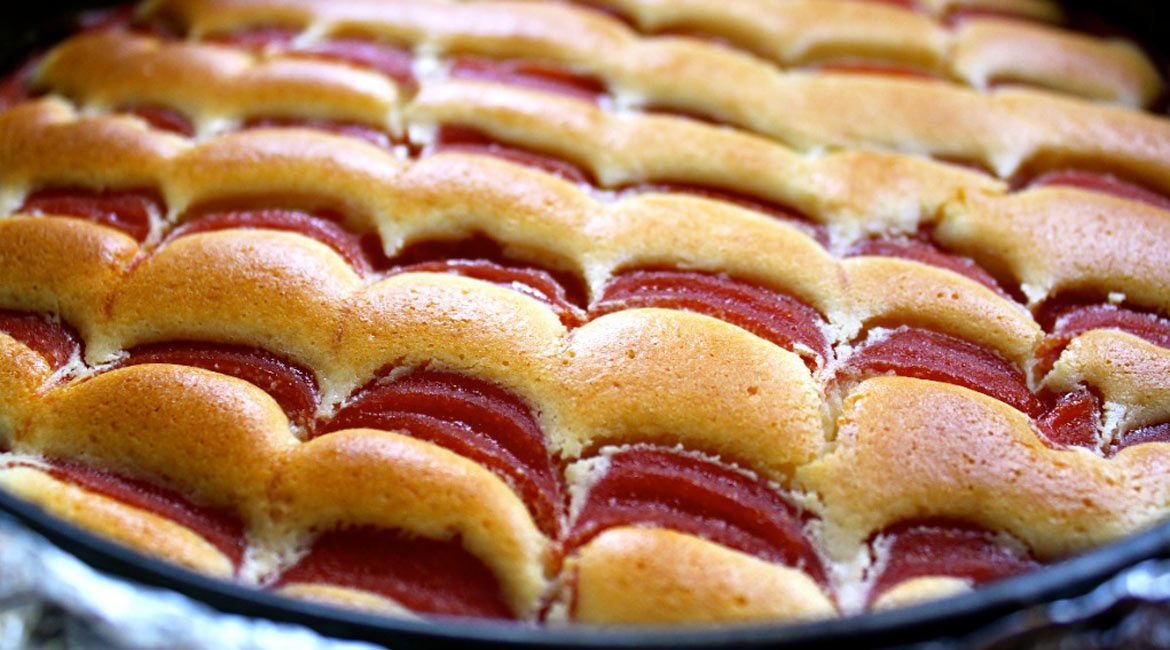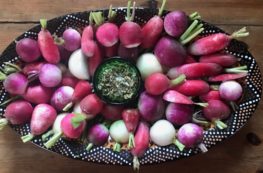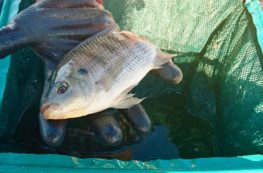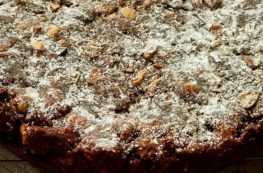Gluts of fresh food, either straight from the tree or from the mountain in the freezer, are always inspirational when it comes to planning a meal for entertaining. On this occasion, for a Sunday lunch with neighbors, I wanted to use up some of our guavas in a dessert. We have bags of them in the freezer, which so far I have used for jelly and cordial. Sometimes we also eat them stewed for breakfast, drenched in cream.
As so often happens here, my choice of dessert is also influenced by the ingredients I have available to me at the time. Having recently traveled up to the capital, Lusaka, I had cream cheese and Greek yogurt in my fridge — hoorah! — therefore a cheesecake was a no-brainer. I thought up this gluten-free guava cheesecake after reading about a similar dessert in The Noshery.



Guavas aren’t native to southern Africa, although they grow and produce like they own the place. They are so abundant in their fruit that at times, before my arrival, Chris was tempted to uproot the lot. The birds are addicted to guavas and, as he discovered, so are many pests. But I’ve persuaded him to leave them be for now, not only to satisfy our feathered friends, but also to satisfy me. I’m addicted, too.
I’ve read that guavas were the favorite food of the Incas and the Aztecs in central and south America, which is where the tree is indigenous. And records in the United States show that Seminole Indians were growing guavas in northern Florida in 1816. It is from the New World that guava trees were transported to Europe, and the Portuguese were responsible for eventually introducing them to southern Africa. They came via Mozambique, a former Portuguese colony, and the Western Cape via Madeira during the late 19th century.
Chris’s trees, here in the Zambezi Valley, are the fecund descendants of those intrepid travelers.

Gluten-free Guava Cheesecake – adapted from The Noshery.
Yield: 10 servings
Ingredients:
Guava purée
- about 12 guavas
- 1/2 cup granulated sugar
- 1/2 lemon, juiced
Base
- 2 cups pecan nuts
- 1 cup dates
- 1/2 cup coconut chips
- good pinch of salt
Filling
- 336 grams/12 ounces cream cheese, softened
- 1 cup plain Greek yogurt
- 1 cup granulated sugar
- 2 teaspoons vanilla extract
- 3 whole eggs
- 2 egg whites
- pinch of salt
Method:
- Defrost the guavas, peel, cut in half, and remove all the pips. (If you are using fresh guavas they will be firmer and easier to handle.)
- Mix in the sugar, lemon juice, and half-a-cup of water with the guava shells and juice in a heavy-based saucepan. Bring to the boil, stirring regularly until the sugar has melted. Once boiling, reduce the heat and simmer the guavas for 30 minutes, stirring occasionally.
- Remove from the heat, cool, and then blend the guava mixture into a purée. Set aside in the refrigerator to cool completely.
- While the guavas are simmering, preheat the oven to 190/375 degrees. Completely enclose the bottom and sides of a 9-inch springform pan with three layers of tin foil, ensuring there’s no way water can seep in while baking in a hot oven. Grease the inside of the pan.
- Place all the ingredients for the cheesecake’s base into a blender, or food processor, and pulse until finely crumbed. (I do this in batches because the dates are sticky and tend to clog up the blade.)

- Spoon the mixture into the springform pan and, using your fist, press it down into the bottom and up the sides a little, to form a compacted crust. Bake in the oven until golden, about 10 minutes, and then cool in the refrigerator while making the filling. Reduce the oven temperature to 170/325 degrees.
- Add a pinch of salt to the egg whites — it assists with breaking the egg white down to allow the air in — and beat until soft peaks form. Set aside.
- In a large bowl combine the cream cheese with the sugar and beat until smooth. Beat in the yogurt and vanilla, and then the whole eggs, one at a time, making sure you end up with a mixture that is pale, smooth and creamy. Gently fold the egg whites into the creamy mixture with a large metal spoon, and pour over the crust.

- Fill a piping bag with the guava purée (or snip a corner off a plastic bag if you don’t own a piping bag; it works just as well). Pipe evenly spaced lines of guava purée up and down the creamy filling, and around the edge. Using a skewer, or sharp knife, pull down the purée in a perpendicular line to create a wave effect.

- Pour two inches of boiling water into a roasting pan in which you carefully place the cheesecake in its foil-covered springform pan. Bake for about 50 minutes, or until center of the cheesecake hardly moves. Turn off the oven, and allow the cheesecake to cool inside for 30 minutes. Remove and run a knife around the outside edge of the cheesecake immediately. Cool on a wire rack. Cover and chill (I usually make mine the day before).






18 Comments
Gorgeous Annabel! Will definitely try this. thanks.
Thank you so much, Cherie! It’s a simple, light dessert to make …
Steve, our resident tropical fruit lover, would be in heaven. What a beautiful cheesecake!
Thank you, Michelle! It’s so easy and much lighter than, say, a New York cheesecake. The guava, of course, could be replaced with any other fruit that makes a good purée.
Looks great Annabel , surely one of the most under rated fruits , thank you for sharing them with us x
Thank you, Liz … and so good to hear from you again. Guavas are indeed underrated and I don’t know why! They have a taste like nothing else I know. It was only when I moved back to Africa that I realized how much I had missed them living abroad. All the best to you … Annabel
Looks and sounds delicious. Guava’s are a real childhood memory. Well done Annabel. Lots of love my friend xxx
Thank you, Di … and so much love to you. xo
Oh the gloriousness of African yellow guavas! And the glorious presentation of your baked guava cheesecake Annabel! We can’t grow those big yellow guavas in NZ. We have to buy South African tinned guavas if we want the real deal. We can grow the tiny red guavas here. They make a glowing red jelly but they’re a poor comparison to the flavours of yellow guavas. Interestingly both species of guava are a serious threat to the unique botanical communities of many sub tropical and tropical islands. They have become a dominant weed replacing the forests in places like Hawaii, Galapagos, Mauritius, because they are spread by birds and adapt to so many conditions. So be careful where you take them!
Lovely to hear from you as always, Alicia, thank you! I’ve read about how invasive guavas can be … their abundance, combined with the sheer number of birds the fruit attracts, can only mean the seed is carried far and wide. We keep a beady eye on our trees, however, and only allow for a dedicated number. Much gratitude for enlightening me further, my favorite biologist!
Jealous. I love guavas wish I could grow them here in Spain but our winters are too cold.
Your cheesecake looks lovely and I am sure delicious. Wish I coukd lay my hands on some guavas to try it.
I once attempted to invent a new drink with guavas when we lived in the Cape. I stewed about 30 kgs till just done then put them into several 5 litre buckets topped up with fortified wine called Jeripigo. I used about 40 litres. So sure that my new “Guavapigo” was going to be a big hit I wasn’t going to waste time with small quantities.
I left my buckets with lids for three months before opening but what a disaster! Instead of finding my new soon to be famous liqueur, a vile, copper coloured, thick and bitter jelly was the result!
Jerepigo is made from Hanepoort grapes and has a lovely honey litchi flavour. A sweet wine but refreshing served very cold with dessert.
Love your story about your Guavapigo! What a shame it never turned out … but kudos to you for trying! I’m partial to a good dessert wine, so I’ll keep my eyes open for the Jerepigo. Here, I make a guava cordial, which could add a certain je nais se quois to a cocktail, or two. (Will have to try it!) Great to hear from you again, Gillian, and thank you for taking the time to stop by my blog.
Reblogged this on nz.
Thank you so much for your interest and support! All the best to you, Annabel
also All the best to you,
Guaven sind die Lieblingsspeise der ost afrika
I am inundated with guavas for about 4-6 months a year just one tree! Give them away to all and sundry but this recipe has inspired me ! Thank you.
Apologies for the slow response to your comment, chitaitai … it’s been a busy weekend! Thank you for your continuing interest. This recipe is very, very easy … and really tasty. I highly recommend it! All the best to you, Annabel
Comments are closed.